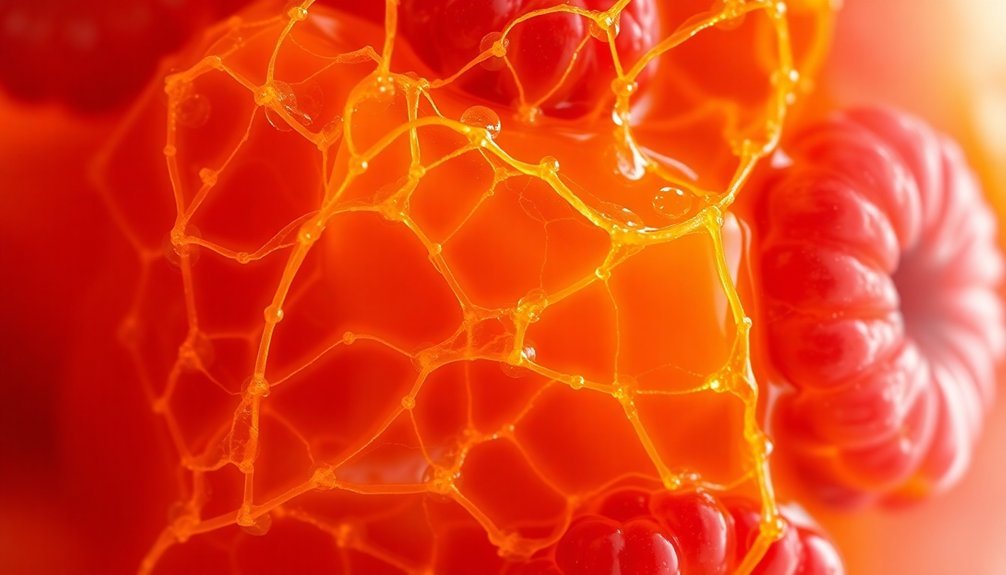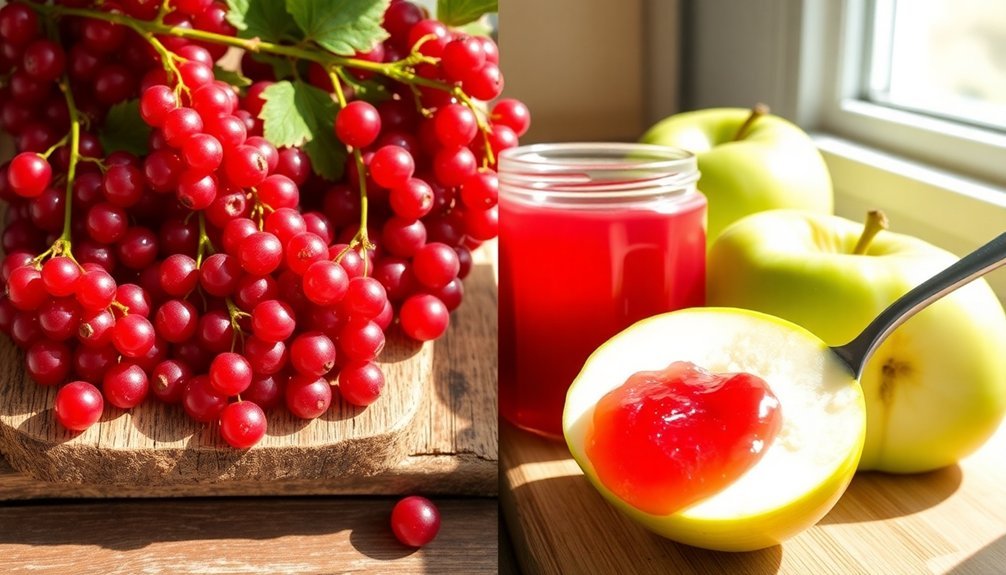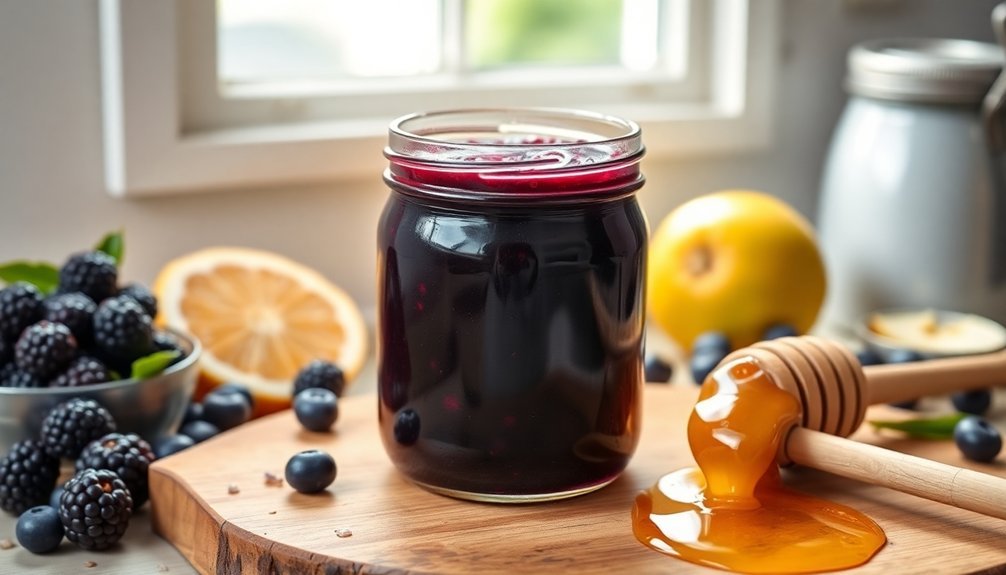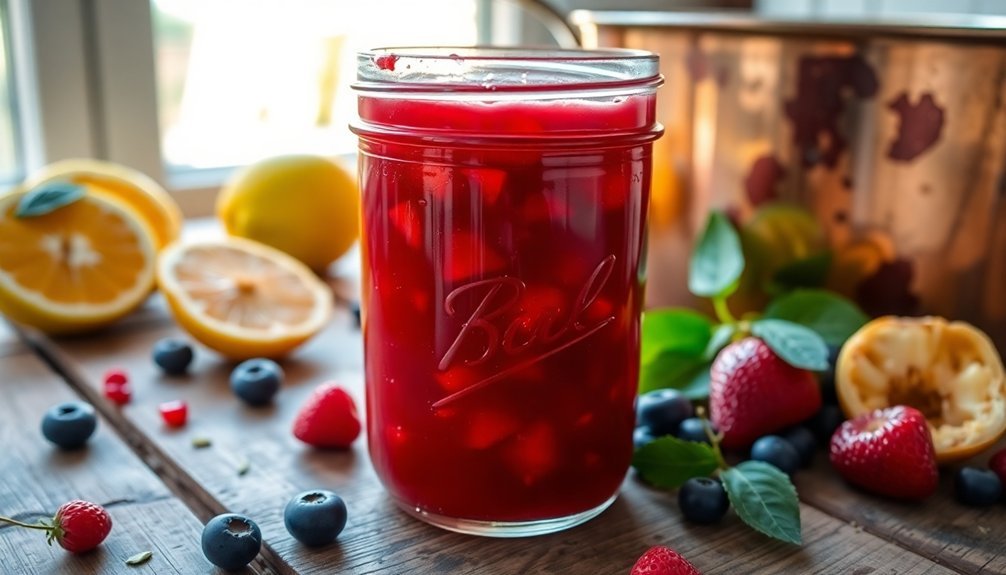Natural low-sugar jams stay fresh through several key factors you'll need to balance carefully. Instead of relying on sugar's preservative power, you'll want to focus on proper acid levels and specialized pectins designed for low-sugar recipes. Using slightly under-ripe fruits helps boost natural pectin content, while maintaining the right pH (3.1-3.6) creates an environment that inhibits spoilage. You'll need to process your jams using proper water bath canning techniques and store them in cool, dark places. With these elements working together, your low-sugar preserves can maintain freshness for up to six months – and there's even more to the preservation puzzle.
The Science Behind Natural Gelling

The science behind natural gelling relies on three key elements working together: sugar, heat, and pectin. When you're making jam, these components interact in a complex process that creates the perfect consistency. The sugar doesn't just sweeten your jam – it plays an essential role by drawing water away from the pectin molecules, allowing them to form a stable gel structure.
As you heat your fruit mixture, you're triggering two important reactions. First, the heat releases natural pectin from the fruit cells. Second, it drives water evaporation, which concentrates your mixture to the ideal consistency. An acidic environment with pH between 3.1-3.6 is necessary for proper gel formation.
You'll need to maintain a temperature around 220°F to reach the essential gel point, but be careful not to overcook, as this can break down the pectin structure.
Adding citric acid or lemon juice can speed up the process by boosting the natural pectin's effectiveness. If you're working with fruits that are naturally high in pectin, you'll need less help achieving the right set.
The key is finding the right balance – you want enough sugar to support gelling (typically 65-69%), but not so much that you overwhelm the natural fruit flavors.
Understanding Pectin and Acid Balance
Creating perfect low-sugar jams requires a deep understanding of how pectin and acid work together in your recipe. When you're making natural low-sugar jams, you'll need to focus on the type of pectin you're using, as low methoxy pectin works best for reduced sugar recipes. Low methoxy pectin effectively binds with calcium instead of sugar to create the perfect set.
The acid in your jam plays an essential role by helping extract pectin from fruit and creating the right environment for gel formation.
To achieve the perfect balance, you'll want to take into account these vital factors:
- Choose fruits that are just barely ripe, as they contain more natural pectin.
- Add lemon juice or citric acid if your fruit lacks natural acidity.
- Monitor your pH levels to guarantee proper gel formation.
Without high sugar content to act as a preservative, you'll need to rely more heavily on the natural preservation properties of pectin and acid.
The acid helps neutralize the negative charge on pectin chains, allowing them to form a stable gel network. When working with low-sugar recipes, you might need to adjust your acid levels slightly higher than traditional recipes to compensate for the reduced sugar content and secure proper preservation.
Fruit Selection for Better Setting

Selecting the right fruit for your low-sugar jam makes all the difference between success and failure.
You'll want to combine both ripe and slightly under-ripe fruit to achieve the perfect balance of pectin, acid, and flavor. The under-ripe portions provide the essential setting properties, while the ripe fruit delivers the sweetness and complex taste you're looking for.
Choose firm, ripe fruits that are preferably organic and in-season for the best results. High acidity levels in fresh fruit help extend your jam's shelf life.
You'll find that local, seasonal fruit offers superior flavor compared to imported options. Before using any fruit, taste it to verify it'll contribute the desired flavor profile to your jam.
Don't use overripe fruit, as it contains less pectin and acid, which will result in a poor set.
If you can't find fresh fruit in season, you can freeze quality fruit when it's available.
Freeze individual pieces on a tray before packaging them, and thaw them in your refrigerator when you're ready to use them.
Remember to prepare your fruit just before use and work in small batches to maintain the highest quality in your final product.
Safe Canning Without Added Sugar
Safe canning without added sugar requires special attention to both equipment and technique to secure a quality preserve that won't spoil.
You'll need to use specially formulated pectin labeled as "light" or "no sugar needed," as regular pectin won't achieve proper gel formation in low-sugar recipes.
The water bath canning process becomes even more critical when reducing sugar, as you'll need longer processing times to prevent bacterial growth.
Make sure you:
- Sterilize jars thoroughly by boiling for 10 minutes or using your dishwasher's sanitize cycle
- Leave exactly 1/4 inch headspace when filling jars with hot jam
- Process jars for the full recommended time, adjusting for your elevation
Without sugar's preservative properties, you'll need to be extra vigilant about food safety.
Always wipe jar rims with vinegar before sealing, and verify you're using approved canning methods like water bath or atmospheric steam canning.
Your low-sugar preserves may set softer and show color changes sooner than traditional jams, so it's important to store them in a cool, dark place and use them within one year for best results.
Natural Preservative Alternatives

| Natural Component | Function | Best Source |
|---|---|---|
| Pectin | Creates gel structure | Citrus peels, apple cores |
| Acid | Activates pectin bonds | Fresh lemon juice |
| Natural Sweeteners | Provides sweetness | Stevia, monk fruit |
You can enhance preservation by adding lemon juice, which serves dual purposes: it provides both acid and natural pectin. For sweetness without refined sugar, you'll find success with concentrated fruit juices, particularly white grape or apple juice. These concentrates not only sweeten but also help maintain the fruit-forward flavor profile. You can adjust the ratios of fruit purees and concentrates to achieve your desired consistency and sweetness level while ensuring proper preservation through the natural pectin network.
Storage Methods and Shelf Stability
When storing your low-sugar jams, you'll need to contemplate three primary methods: freezer storage, refrigeration, or water bath canning. Your freezer offers the longest preservation time, keeping your jam fresh for up to a year while preventing microbial growth. You'll want to thaw frozen jams overnight in your refrigerator before use.
For refrigerated storage, you can expect your low-sugar jams to last 1-2 months, while jams made with Splenda should be consumed within a month. Keep the temperature at 40°F or lower to slow down spoilage. Water bath processing can extend shelf life to about 6 months when stored in a cool, dark place between 50-70°F.
Remember these critical points when storing low-sugar jams:
- Sugar content below 55% means less stability and shorter shelf life
- Regular inspection for mold, yeast, or off-odors is essential
- Proper sealing and storage conditions directly impact preservation time
You'll notice that low-sugar jams may experience changes in color, flavor, and texture over time. This is normal, but you should always check for signs of spoilage before consuming, regardless of your chosen storage method.
Frequently Asked Questions
Can I Use Frozen Fruit to Make Low-Sugar Jam?
Yes, you can use frozen fruit for low-sugar jam! You'll find it's convenient and available year-round. Just add it directly to your recipe, and it'll work perfectly since frozen fruit maintains its nutritional value.
Why Does My Low-Sugar Jam Crystallize After Several Weeks?
Your low-sugar jam's crystallizing because you're using less sugar to bind with water molecules. Excess sugar, slow cooling, temperature fluctuations during storage, and natural fruit acids can all trigger crystal formation.
How Do Different Altitudes Affect the Setting Time of Natural Jams?
At higher altitudes, you'll need more cooking time since water boils at lower temperatures. Your natural jams will take longer to reach their setting point, requiring about 5 extra minutes per 1,000 feet elevation.
Can Fermented Fruit Be Used for Making Low-Sugar Preserves?
Yes, you can use fermented fruit to make low-sugar preserves. The fermentation process naturally reduces sugar content while creating beneficial probiotics. You'll get a tangy, preserved product that's healthier than traditional sugar-heavy jams.
Does Stirring Direction Impact the Consistency of Natural Low-Sugar Jams?
No, you don't need to worry about stirring direction when making low-sugar jams. What matters most is maintaining proper temperature, using the right pectin, and ensuring consistent stirring throughout the cooking process.
In Summary
You've discovered that creating shelf-stable, low-sugar jams relies on careful fruit selection, proper pectin levels, and safe canning methods. By balancing natural acids, choosing high-pectin fruits, and using alternative preservatives like citrus juice or honey, you'll achieve the perfect set without excess sugar. Remember to store your jams in sterilized jars, keep them in cool, dark places, and always check for signs of spoilage before consuming.





Leave a Reply